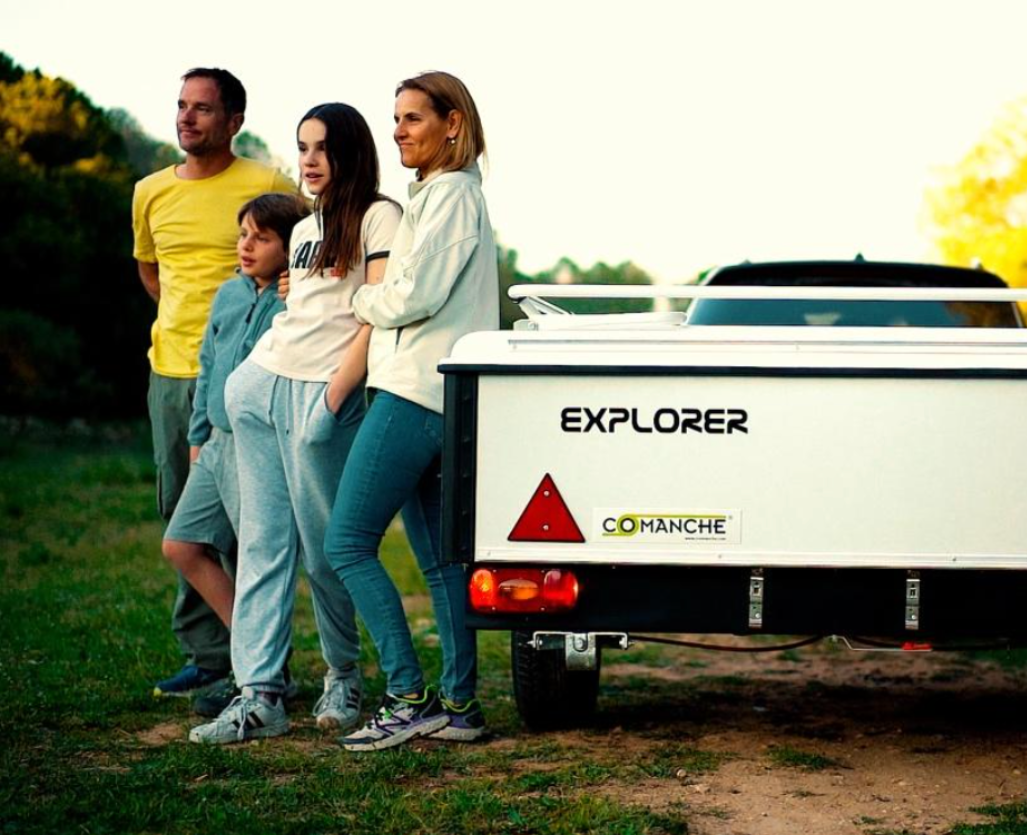
Spring has arrived and we are seeing more and more cyclists on the road. If you are a bicycle lover, you have probably already tuned it and taken its first rides on the road.
Also when you go away for the weekend, on a getaway or on vacation, you like to take your bike with you. Once at your destination, it is your best ally for short and quick trips, for entertaining children or simply for sports.
You already know that carrying your bike or the entire family's bikes in the trunk is impossible.. If you have encountered this problem, you have probably already looked at some bicycle racks on the market.
And then you found that There are so many models, systems and factors to consider that you have only become more overwhelmed.…
For this reason, we have decided to make a short review of bicycle rack models that we have tested so that you can choose the most suitable one for you.
What types of bicycle racks are there?
As we have said, there are a variety of models, fastening systems, capacities and qualities of bicycle racks. Each type has its specific characteristics that respond to the different needs of users.
There are bike racks:
- ceiling
- Wrecking ball
- tailgate
- 4×4 wheel
- For 2, 3, 4 and more bikes
- Up to a certain weight
- Easy to assemble
- Convenient to load
- Ergonomic
With all this, choosing the one that best suits your needs can be difficult. Here is our small analysis of the pros and cons of each model.
For roof
It is the system most popular, especially because it is the cheapest. It also does not bother when opening the trunk and once installed it can be left on. for the most frequent use. If you want to disassemble it almost It does not take up space and is easily stored. You can find models for 1 single or several bicycles.
But not everything are advantages. He roof bike rack can be one of the complicated to assemble. First you will need a roof rack to be able to hold it and being a mounting at height can be uncomfortable. A big drawback is also its aerodynamic drag, which will cause you will use more gasoline. Therefore this system is recommended for shorter trips.
You will also need a little arm strength to lift the bike to the roof of your car. And finally be careful with garages, you will have to remember that your car now takes up more space vertically.
For tailgate
Tailgate bike rack It is a system of bars that are attached with hooks and tapes to the back of the car. It is also Quite economical and very easy to load and unload the bikes. Is Adjustable to many car models which makes it very popular among users. Once disassembled, it takes up little space in the trunk. It will permit you carry between 2 and 4 bicycles of different sizes.
Its main disadvantage is that once installed makes it impossible to open the rear door and almost completely eliminates the visibility of the center mirror. It must also be taken into account that bicycles cannot exceed the car width (side mirrors included) so it is not recommended for tandem bicycles. You have to use a V-20 type plate, a square panel with red and white stripes and the second license plate if it covers the original.
If you decide on this type of fastening Make sure that all the pieces have rubber and foam in the parts that touch the car. It is very possible that without them scuffs and scratches will appear on the paint. It also secures the bikes between them so they don't get scratched.
For tow ball
This system is perfect for long distances and if you need to carry more than one bike (they can be of different sizes and frames). His installation is quick and easy, as long as you choose the right model for your car. Its great advantage is that you will be able to open the trunk without having to remove it. It generally incorporates rear lights and a space prepared for the second license plate, since it will cover the original one of the car. With this model you can sleep peacefully because can be completely locked to the ball to prevent theft and it is also very safe due to its perfect attachment to the vehicle.
Its disadvantages: above all the price, not only of the bicycle rack but also of the previous installation of the car ball (from €200). You will also need to place the second license plate and V20 outgoing load signaling plate. When maneuvering you will have to take into account the new length of the vehicle and if you want to dismantle it, you will need a little extra space in the trunk to store it.
Bicycle rack for cars with 4×4 rear wheel
It's a Universal bicycle rack for off-road vehicles with rear wheel. The models we have at Comanche have capacity for 3 bikes and are suitable for any 4×4 that has a centered rear wheel without a cover. Are approved and you do not need to pass the ITV with them. Depending on the model, you will place the bicycles on rails or hang them from arms that can be offset to the sides.
To place this bike rack you must remove any cover or casing that the wheel has, since it is placed on the spare wheel directly. It is also mandatory to outgoing load signaling plate (V-20) and you may need to attach an additional pilot and license plate.
Bike rack for camping trailers
And of course, if you are a camper like us, the best solution is a bike rack to mount on top of your camping trailer. In Comanche we have specially designed to fix them on the roof rack of your tent trailer.
They are bike racks robust and safe, which take advantage of the roof rack to fix the guide. They also include a cross tube, which will more resistance to the whole. They are very safe, since each bicycle rack includes a anti-theft key and thread, to prevent the bike from being stolen, when you make a stop.
These bike racks are integrated into the roof rack, therefore, you don't need to disassemble them to open the tent trailer. They have capacity for up to 4 bicycles of different sizes and frames.
We currently have this system for the Kenya, Compact and Montana models but do not hesitate to contact us for any other Comanche model, we will find the solution.
What should be taken into account when buying a bicycle rack?
As you can see, there are a variety of solutions to secure your bicycle in the car or on your trailer. Which one best suits your needs will depend on several factors:
- The distance you are going to travel with your bike rack
- Ease and convenience of assembly
- The model of the car you have
- The number of bicycles you want to carry
- The frequency with which you are going to use it
- The space you have to store it once dismantled
- The price you are willing to pay
- The mandatory modifications and accessories you will need to add
- The security offered by each model (both during transport and stays)
And what do manufacturers recommend about transporting bicycles?
- Before mounting your bicycle rack, carefully read the Assembly instructions.
- If you bicycle rack is ball, apply a degreaser to it so that the system is fixed correctly. Also adapt your driving style to these new conditions. Be especially careful when cornering and when braking and reversing.
- Before starting the journey, check if all the lights work properly.
- Check the correct tightening of the parts of the transported bicycles and remove accessories and additional devices to avoid loss.
- Keep the straps in perfect condition, do not use straps from other fixing systems, only the original ones and do not leave them loose to prevent them from “floating” during transport.
- Distribute bicycles compactly on the bicycle rack and as close to the car as possible.
- Bicycle tires should be kept away from the exhaust pipe, since hot gases can damage them.
- Check that no metal part of the bicycle rack touches the body of the car to avoid scratches.
- The anchoring system must be always locked during the march.
- You must always comply with the traffic regulations and speed limits allowed. The maximum speed should not exceed 110km/h.
- Do not use the bicycle rack in unpaved roads, you can damage both the bike rack and your car.
- Always consult the maximum load of your restraint and do not exceed it under any circumstances.
- According to current regulations in Spain, your bicycle rack cannot exceed vehicle width more than 15% of its total length.
- It is also mandatory in Spain to place, in a visible place, a Approved loading projection sign plate (V20). Find out about obligations in other countries if you are going to travel abroad.
- Do not tamper with or modify your bike rack. You will lose the manufacturer's warranty and above all the official approval of the product.
- You are the only one responsible for the correct placement of the device, that it is in perfect condition and securely attached to the hitch. These recommendations are not limited and do not exempt you from complying with the basic rules of prudence and common sense. If you notice any anomaly, contact your distributor before any use.
We know that choosing the right bike rack for you and your family is not an easy task. We hope we have clarified the differences between so many models that exist on the market.
Check our Online store And if you still have questions, do not hesitate to contact us, we will surely find solutions for your case.
E-mail: info@rcomanche.com
Telephone: +34 93 892 10 45
You dare? Load the family, suitcases and bicycles in the car and enjoy a few days of relaxation.









